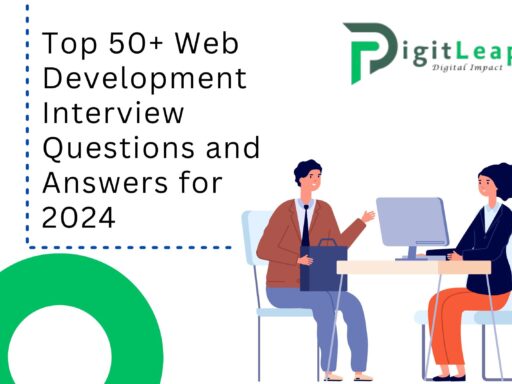Top 50+ Social Media Marketing Interview Questions and Answers for 2024
Social media marketing continues to be a vital aspect of digital strategy, offering brands a powerful platform to connect with their audience. Whether you’re an experienced social media manager or new to the field, preparing for an interview is crucial. This guide presents over 50 essential social media marketing interview questions and answers to help you showcase your expertise and stand out in your next job interview.
1. What is Social Media Marketing (SMM)?
Answer: Social Media Marketing (SMM) involves using social media platforms to promote a brand, increase engagement, and drive traffic to a website. It includes creating and sharing content, running paid advertisements, and engaging with followers to build a community.
2. What Are the Key Benefits of Social Media Marketing?
Answer: The key benefits of social media marketing include increased brand awareness, enhanced customer engagement, improved website traffic, valuable insights into customer behavior, and the ability to drive sales through targeted advertising.
3. What Social Media Platforms Should a Business Use?
Answer: The choice of social media platforms depends on the business’s target audience and objectives. Common platforms include Facebook, Instagram, Twitter, LinkedIn, Pinterest, and TikTok. Each platform has unique features and demographics, so select based on where your audience is most active.
4. How Do You Define and Measure Social Media Success?
Answer: Social media success is defined by achieving your marketing goals, such as increasing brand awareness, engagement, or conversions. Measure success using metrics like reach, impressions, likes, shares, comments, click-through rates, and conversion rates. Tools like Google Analytics and social media insights can help track these metrics.
5. What Is the Role of Content in Social Media Marketing?
Answer: Content is central to social media marketing as it drives engagement and communicates the brand’s message. High-quality, relevant content tailored to the platform and audience can foster interactions, build relationships, and encourage sharing.
6. How Do You Create a Social Media Strategy?
Answer: To create a social media strategy, start by defining your goals, identifying your target audience, choosing the right platforms, and developing a content plan. Set measurable objectives, create a content calendar, and establish a plan for engaging with your audience and measuring performance.
7. What Is Social Media Analytics and Why Is It Important?
Answer: Social media analytics involves collecting and analyzing data from social media platforms to evaluate performance and make data-driven decisions. It’s important because it helps measure the effectiveness of campaigns, understand audience behavior, and optimize future strategies.
8. How Do You Handle Negative Comments or Reviews on Social Media?
Answer: Handle negative comments or reviews professionally and promptly. Acknowledge the issue, apologize if necessary, and offer to resolve the problem offline or in private messages. Maintaining a positive tone and addressing concerns can help manage the brand’s reputation.
9. What Are Paid Social Media Advertisements?
Answer: Paid social media advertisements are sponsored content that appears on social media platforms to reach a targeted audience. These ads can be in various formats, including image ads, video ads, carousel ads, and sponsored posts, and are used to drive traffic, increase engagement, or generate leads.
10. What is Social Media Engagement and How Do You Increase It?
Answer: Social media engagement refers to the interactions users have with your content, such as likes, comments, shares, and follows. Increase engagement by posting relevant and high-quality content, using interactive features like polls and questions, and engaging with your audience through comments and messages.
11. How Do You Choose the Right Social Media Platforms for a Business?
Answer: Choose the right platforms based on the business’s target audience, industry, and goals. Research where your audience is most active and consider each platform’s strengths and features. For instance, Instagram is great for visual content, while LinkedIn is ideal for B2B networking.
12. What is a Social Media Content Calendar and Why Is It Important?
Answer: A social media content calendar is a schedule that outlines what content will be posted, when, and on which platforms. It’s important for maintaining consistency, planning campaigns, and ensuring that content aligns with marketing goals and key dates.
13. How Do You Measure the ROI of Social Media Campaigns?
Answer: Measure the ROI of social media campaigns by calculating the return on investment based on metrics such as revenue generated, cost per acquisition, and overall campaign costs. Compare these metrics to the initial investment to determine profitability.
14. What Are Social Media Influencers and How Can They Benefit a Brand?
Answer: Social media influencers are individuals with a large and engaged following on social media. They can benefit a brand by endorsing products, reaching a wider audience, and providing authentic recommendations, which can drive engagement and sales.
15. What is Social Media Automation and How Can It Be Used?
Answer: Social media automation involves using tools and software to schedule and manage social media posts, monitor mentions, and analyze performance. It helps streamline tasks, maintain consistency, and free up time for strategic planning.
16. How Do You Stay Updated with Social Media Trends and Changes?
Answer: Stay updated with social media trends by following industry blogs, attending webinars, participating in online communities, and keeping an eye on platform updates and new features. Networking with other professionals can also provide valuable insights.
17. What is User-Generated Content and How Can It Be Leveraged?
Answer: User-generated content (UGC) is content created by users or customers, such as reviews, photos, or videos. It can be leveraged by sharing it on your brand’s social media channels, encouraging more UGC, and building trust and authenticity with your audience.
18. How Do You Handle Social Media Crisis Management?
Answer: Handle social media crises by having a crisis management plan in place. Respond quickly and transparently, address the issue head-on, and communicate clearly with your audience. Monitor the situation closely and adjust your strategy as needed.
19. What Are Social Media Metrics and Which Ones Are Most Important?
Answer: Social media metrics are quantitative measurements used to assess the performance of social media activities. Important metrics include reach, impressions, engagement rate, click-through rate, conversion rate, and follower growth.
20. How Do You Conduct a Social Media Audit?
Answer: Conduct a social media audit by evaluating your social media profiles, content, engagement, and performance. Analyze what’s working and what isn’t, compare with competitors, and use the findings to improve your strategy and tactics.
21. What is Social Listening and How Can It Benefit a Brand?
Answer: Social listening involves monitoring social media channels for mentions of your brand, competitors, and industry keywords. It can benefit a brand by providing insights into customer sentiment, identifying trends, and informing content and engagement strategies.
22. How Do You Create Engaging Social Media Content?
Answer: Create engaging social media content by understanding your audience’s interests and preferences, using visually appealing elements, incorporating storytelling, and encouraging interaction through questions, polls, and calls-to-action.
23. What Are Social Media Algorithms and How Do They Affect Content?
Answer: Social media algorithms determine how content is displayed in users’ feeds based on factors like relevance, engagement, and user behavior. Understanding these algorithms helps optimize content to increase visibility and engagement.
24. What is the Importance of Social Media Branding?
Answer: Social media branding is important because it helps establish and reinforce a brand’s identity and values. Consistent branding across social media platforms builds recognition, trust, and loyalty among the audience.
25. How Do You Optimize Social Media Profiles?
Answer: Optimize social media profiles by using a clear and professional profile picture, writing a compelling bio or description, including relevant keywords, and ensuring contact information and links are up-to-date and accurate.
26. What Are Some Common Social Media Marketing Mistakes to Avoid?
Answer: Common social media marketing mistakes include inconsistency in posting, neglecting audience engagement, ignoring analytics, not having a clear strategy, and failing to adapt to platform changes or trends.
27. How Do You Use Hashtags Effectively in Social Media?
Answer: Use hashtags effectively by researching relevant and trending hashtags, using a mix of popular and niche hashtags, and avoiding overloading posts with too many hashtags. They help increase visibility and reach a broader audience.
28. What is the Role of Paid Social Media Campaigns?
Answer: Paid social media campaigns play a role in reaching a targeted audience, driving traffic, and generating leads or sales. They allow for precise targeting based on demographics, interests, and behavior and can complement organic efforts.
29. How Do You Develop a Social Media Advertising Strategy?
Answer: Develop a social media advertising strategy by defining your objectives, identifying your target audience, choosing the right ad formats, setting a budget, and creating compelling ad content. Monitor performance and adjust the strategy based on results.
30. What Are the Benefits of Cross-Promoting Content Across Social Media Platforms?
Answer: Cross-promoting content across social media platforms increases reach and engagement, drives traffic to your main channels, and helps maintain a consistent brand message. It allows you to leverage each platform’s unique audience.
31. How Do You Manage Social Media Campaign Budgets?
Answer: Manage social media campaign budgets by setting clear objectives, allocating funds based on priority and expected ROI, monitoring spending, and adjusting the budget as needed based on campaign performance and results.
32. What is A/B Testing in Social Media Marketing?
Answer: A/B testing involves creating two variations of content or ads and testing them against each other to determine which performs better. It helps optimize strategies by providing insights into what resonates most with your audience.
33. How Do You Engage with Influencers for Collaborations?
Answer: Engage with influencers by identifying those whose audience aligns with your brand, reaching out with a personalized pitch, and offering mutually beneficial collaboration opportunities. Establish clear expectations and maintain open communication throughout the partnership.
34. What is Social Media Retargeting and How Does It Work?
Answer: Social media retargeting involves showing ads to users who have previously interacted with your brand or website. It works by using cookies or tracking pixels to identify and target these users with relevant ads, increasing the chances of conversion.
35. How Do You Handle Social Media Privacy and Security Issues?
Answer: Handle social media privacy and security issues by ensuring your accounts have strong passwords, using two-factor authentication, regularly reviewing privacy settings, and monitoring for suspicious activity. Educate your team on best practices for online security.
36. What is the Importance of Social Media Integration with Other Marketing Channels?
Answer: Social media integration with other marketing channels ensures a cohesive and unified brand message. It enhances the effectiveness of campaigns, improves customer experience, and maximizes the impact of your marketing efforts.
37. How Do You Leverage Data and Analytics for Social Media Strategy?
Answer: Leverage data and analytics by analyzing performance metrics, understanding audience behavior, and identifying trends. Use these insights to refine your strategy, optimize content, and make data-driven decisions for better results.
38. What is the Role of Visual Content in Social Media Marketing?
Answer: Visual content plays a crucial role in social media marketing as it attracts attention, increases engagement, and conveys messages more effectively. High-quality images, videos, and graphics can enhance your brand’s appeal and drive interactions.
39. How Do You Ensure Social Media Content Is Aligned with Brand Values?
Answer: Ensure content alignment with brand values by maintaining consistency in tone, messaging, and visuals. Review content for adherence to brand guidelines and ensure it reflects the brand’s mission, values, and voice.
40. What Are Social Media Contests and How Can They Be Used?
Answer: Social media contests are promotions where users participate to win prizes by engaging with your content. They can increase brand visibility, drive engagement, and attract new followers. Ensure contests are well-planned, clearly communicated, and compliant with platform rules.
41. How Do You Approach Social Media Customer Service?
Answer: Approach social media customer service by providing timely and helpful responses to inquiries and complaints. Maintain a professional and empathetic tone, address issues promptly, and use feedback to improve customer experience.
42. What is a Social Media Policy and Why Is It Important?
Answer: A social media policy outlines guidelines for how employees should use social media on behalf of the company. It’s important for maintaining brand consistency, protecting the company’s reputation, and ensuring compliance with legal and ethical standards.
43. How Do You Track and Report Social Media Performance?
Answer: Track and report social media performance by using analytics tools to monitor key metrics, such as engagement, reach, and conversions. Compile regular reports to evaluate campaign effectiveness, identify trends, and make informed decisions.
44. What is a Social Media KPI (Key Performance Indicator)?
Answer: A Social Media KPI is a measurable value used to assess the success of social media activities in achieving business objectives. Common KPIs include engagement rate, click-through rate, follower growth, and conversion rate.
45. How Do You Optimize Social Media Ads for Better Performance?
Answer: Optimize social media ads by targeting the right audience, using compelling visuals and copy, testing different ad formats, and analyzing performance data. Continuously refine your ads based on insights and feedback to improve results.
46. What Are the Benefits of Using Video Content on Social Media?
Answer: Video content offers several benefits, including higher engagement rates, the ability to convey complex messages effectively, and increased shareability. Videos can capture attention, tell compelling stories, and drive conversions.
47. How Do You Manage Social Media Accounts for Multiple Brands?
Answer: Manage social media accounts for multiple brands by developing separate strategies for each brand, using social media management tools, and ensuring consistent brand voice and messaging. Organize tasks with a clear schedule and monitor performance individually.
48. What is the Importance of Social Media Listening Tools?
Answer: Social media listening tools are important for monitoring brand mentions, analyzing sentiment, and identifying trends. They provide valuable insights into audience perceptions and competitor activities, helping to inform your social media strategy.
49. How Do You Utilize User Feedback from Social Media?
Answer: Utilize user feedback from social media by analyzing comments, reviews, and messages to identify common themes, address concerns, and improve products or services. Use positive feedback to enhance brand reputation and tailor future content.
50. What Strategies Do You Use to Increase Social Media Followers?
Answer: Increase social media followers by creating high-quality content, engaging with your audience, running contests or giveaways, collaborating with influencers, and promoting your social media profiles through other marketing channels.
51. How Do You Handle Social Media Account Hacking?
Answer: Handle social media account hacking by immediately changing passwords, notifying the platform’s support team, and reviewing recent activity for unauthorized changes. Implement security measures such as two-factor authentication and educate your team on security best practices.
52. What is the Role of Social Media in Crisis Management?
Answer: Social media plays a critical role in crisis management by providing a platform for timely communication, addressing concerns, and managing public perception. It helps in disseminating accurate information and maintaining transparency during a crisis.
53. How Do You Create a Social Media Marketing Budget?
Answer: Create a social media marketing budget by determining your goals, estimating costs for content creation, advertising, tools, and staffing. Allocate funds based on priorities and expected ROI, and regularly review and adjust the budget as needed.
54. What is Social Media Marketing Automation?
Answer: Social media marketing automation involves using tools and software to streamline and automate tasks such as posting, scheduling, and reporting. It helps save time, maintain consistency, and improve efficiency in managing social media activities.
55. How Do You Incorporate Social Media into Your Overall Marketing Strategy?
Answer: Incorporate social media into your overall marketing strategy by aligning social media goals with broader marketing objectives, integrating campaigns across channels, and ensuring consistent messaging. Use insights from social media to inform other marketing efforts.






